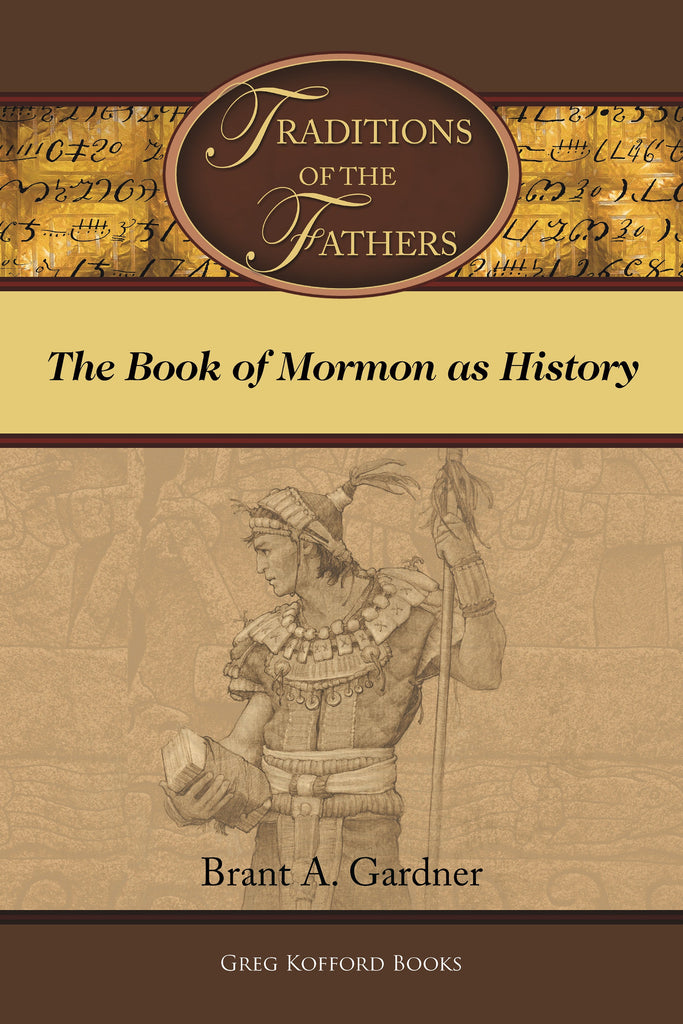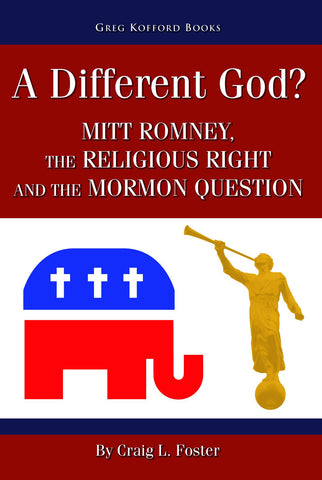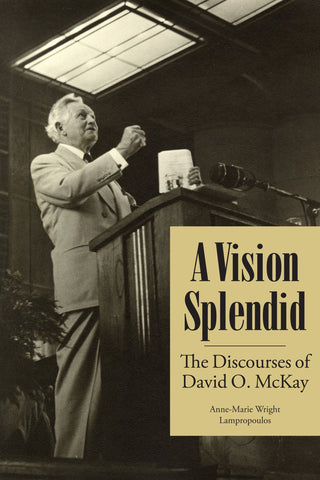Traditions of the Fathers: The Book of Mormon as History
$34.95
2015 Best Religious Non-fiction Award, Association for Mormon Letters
- “Provides readers with illuminating, prismatic views of the Book of Mormon.” — Mark Alan Wright
- “Rich, thorough, provocative.” — Association for Mormon Letters
- “Careful readers of the Book of Mormon ... will be both challenged and deeply rewarded.” — Journal of Book of Mormon Studies



Available in ebook for Kindle, Nook, Kobo, Google Play, and Apple.
Also available through Amazon and Deseret Book.
Download a free sample preview.
Book Description:
The focus of the Book of Mormon is unquestionably on the things of God. Similar to the Bible, its sermons and explications of religious principles are presented against the framework of the story of a people. It is a story that covers a thousand years. In this book Brant Gardner looks around and behind the religious purposes of the book and teases out how those thousand years of Book of Mormon history correspond to those same years in the geographic and cultural context where they most plausibly took place.
Gardner works through the Book of Mormon chronologically, examining how events in the Book of Mormon reflect the greater historical and cultural developments happening around them at the same time. Gardner asks and answers questions against particular historical backdrops. Why does Nephi appear to be so Christian so long before Christ, and why does his particular time period in Jerusalem help answer that question? Why do Nephi apostate groups from different times appear to adopt the same religion? Why does the Book of Mormon end around A.D. 400? Why not earlier or later? The answers are developed by looking at the Book of Mormon as history in the context of what has become known of Mesoamerican history. Along the way, Gardner also looks at the problem of anachronisms, DNA, and some popular “proofs” of the Book of Mormon that need to be abandoned.
AuthorCast Interview with the Author:
Comprehensive Table of Contents:
.
Preface
Introduction
1. Finding a Lost People
In the Beginning: The Bible as Paradigm
The Pre-Critical Use of External Evidence
Scholarship Joins Faith
2. Reading a Lost Book
Reading the Book of Mormon
Reading through the Text’s Analytical Layers
Reading through an Ancient Document’s Translation Layer
Reading through an Ancient Document’s Composition Layer
Reading Archaeology against the Book of Mormon
Reading from a Solid Foundation
This Reading
3. A Prophet without Honour
Judah in Its World
Judah and Its People
Lehi of Jerusalem
Israel’s Sin According to Lehi (and Nephi)
Israel’s Sin and Lehi’s Family Dynamics
Lehi as a Fleeing Prophet
The First Camp
4. The Lehite Exodus
Returning for the Brass Plates
The Importance of the Brass Plates
Lehi’s Prophecy: How Long is a Year?
A Tree in a Dream
A Tree in Stone
Shazer and the Failed Bows
The Place Which Was Called Nahom
Eastward to Bountiful
Bountiful after Privation
Sailing to the New World
Nephi Ends a Book: Nephi Starts a Book
5. Book of Mormon Geography in the New World
Where in the World?
Which Sidon River?
Directions in the Book of Mormon
6. Nephites in a New World
The New Neighbors
Becoming Nephites and Lamanites
The Lamanite Skin of Blackness
Establishing the People and the City of Nephi
New World Peoples in Nephi’s Community
DNA and the Book of Mormon
Nephi: Prophet and Author
Defending the Community
King by Popular Demand
The Nephite Egalitarian Ideal
7. The Nephites in a Dark Tunnel: From Jacob to Omni
Pre-Christian Christianity
Early Economic and Social Tension
Early Religious Tension
Nephites in Armed Conflict
Emerging from the Dark Tunnel
8. Nephites Arrive in Zarahemla
A New World Fleeing Prophet
Zarahemla before the Nephites
The Ancestor, Mulek
Merging Peoples in Zarahemla
Translating a Stone
9. A New Covenant Made, then Unmade
A New Covenant of Unity
Clues to Culture in Benjamin’s Speech
Unmaking Unity: Churches
Unmaking Unity: The Reign of Judges
The Voice of the People
A Mesoamerican Model for Nephite Judges
The Nephite Confederacy
10. The Cultural Context of Nephite Apostasy
Elements of Nephite Apostasy
Cultural Manifestations of Apostasy
Syncretization of Nephite Beliefs
Bridging the Nature of God
Bridging Heavenly Expectations
The Divine King Replaces the Heavenly King
The King, Ritual, and the Replacement of the Messianic Expectation
Explaining Nephite Apostasy
11. Kinship: Tribes and Households
12. Glimpses of Lamanite Culture
Zeniff Returns to the Land of Nephi
Culture as Explanation: Ammon and King Lamoni
Horses, Chariots, and Other Anachronistic Nouns
The Overking and Subordinate Kings
The Treatment of Important Captives
Culture as Explanation: Anti-Nephi Lehies
13. “The Tribulations of our Warfare”
Why Did Lamanites War Against Nephites?
Seasonality of Warfare
Tactics and Order of Battle
Big Numbers and Missing Bodies
14. The Gadianton Robbers in Typology and History
The Narrative Role of Secret Combinations
A Plausible Identification of the Gadiantons
Two Millennia of Disappearing and Reappearing Secret Combinations
From Threads to Tapestry
15. The Dreadful Groanings
The Geology behind the Descriptions
A Recent Reconstruction
16. A Bridge Too Far: Quetzalcoatl and Jesus Christ
From Native to Spaniard: Through the Mirror, Darkly
Topiltzin Quetzalcoatl: King in Tula
Ehecatl Quetzalcoatl: The Deity in Heaven
Ce Acatl Quetzalcoatl: The Deity on Earth
Old Things Are New Again
17. Mormon and the Nephite Demise
The Mesoamerican Cumorah
The New York Cumorah
18. Jaredites in the Text
The Translation of the Jaredite Record and the Tower
Finding Large and Mighty Men
Approximating a Jaredite Chronology
19. Jaredites in the New World
Jaredites, Olmecs, and Warfare
Jaredites, Olmecs, and Texts
Jaredites, Olmecs, and Geography
20. Historicity and Futurity
Geo-spatial Convergences
Geopolitical Convergences
Chronological Convergences
Cultural Convergences
Productive Convergences
From Traditions of the Fathers to Future Stories
Bibliography
Index
Q&A with the Author:
.
Q: You've already commented extensively on the Book of Mormon, first in your multi-volume Second Witness: Analytical and Contextual Commentary on the Book of Mormon, and The Gift and Power: Translating the Book of Mormon. How does this volume differ from these previous volumes?
A: Second Witness was an attempt to provide a comprehensive commentary on the Book of Mormon that included multiple perspectives, including a historical context. There is so much in Second Witness, that only the most persistent reader could gain a chronological understanding of how the Book of Mormon fits into a particular time and place. Traditions of the Fathers concentrates on the story rather than the doctrine. It pulls together the history in a more compact and more easily readable form. It also includes information and insights available since the publication of Second Witness.
Q: There are many volumes dedicated to investigation and study of the Book of Mormon, including the questions of its historicity. What makes this book stand out from those?
A: Even the best of the previous volumes on the history and historicity of the Book of Mormon use somewhat of a shotgun approach to understanding the text. Some have had better aim, but the process has still been to rely heavily on proposed similarities--that sometimes are not that similar. Traditions of the Fathers looks more closely at tying together multiple types of information belonging to the same time and location, as well as providing some in-depth analysis of some previous suggestions that were more enthusiastic than correct. In addition, the intent of the book is not necessarily to provide proofs of the Book of Mormon, but rather to give it the kind of historical and cultural background that we have for the Old and New Testament. Understanding those historical and cultural contexts can deepen our understanding of the Bible, and the proper historical and cultural background for the Book of Mormon should similarly deepen our understanding.
Q: What is most valuable about this book for the believing Latter-day Saint? What is there to recommend it for the interested reader who is not a believing Latter-day Saint?
A: The believing Latter-day Saint should begin to see the people and actions recounted in the Book of Mormon in new and more human ways. The characters and events of the Book of Mormon should become more real, and therefore we should be able to see our own humanity transformed in similar spiritual ways. For those who are not believing Latter-day Saints, Traditions of the Fathers can provide a way to understand why Latter-day Saints accept it as history, even when many assume that it doesn't seem similar to known populations. Those similarities and the way to see the Book of Mormon in history should be easier to understand.
Q: Can you give us an example or two of the work you do in teasing out the culture and context for where the Book of Mormon is said to take place?
A: There are two important aspects to placing the Book of Mormon in time and space. The first is to find the right place, since the text provides the timeframe. Geography is only a first step to that determination. Other major factors deal with the people discussed in the text. For example, there is no direct communication between Jaredites and Nephites. There is the last king of the Jaredites who lives with the people in Zarahemla before the Nephites arrive. That tells us that there must be a physical separation between the original Nephite lands and those of the Jaredites.
Once there is a time and place, the culture of the area is compared to the events in the Book of Mormon to see if there are correspondences where the Book of Mormon is reflecting the culture or events at the appropriate times. That comparison leads to insights elaborated in Traditions of the Fathers about why Nephi's people wanted a king, why Mosiah fled at the time he did (and in the direction he did), why Mormon is so interested in the Gadiatons, and why the Nephite final battle occurred when it did and not earlier (or later).
Q: What are some of the ways of discussing the Book of Mormon and historicity that you find are not helpful or are even detrimental?
A: When the approach to discussing Book of Mormon historicity doesn't have sufficient controls on the evidence presented, it is too easily dismissed. It is also dangerous when believers start to base testimonies on fundamentally flawed approaches.
Q: How might you describe the current state of Book of Mormon studies? What do you hope to see in the future?
A: This is a very interesting time for Book of Mormon studies. There are a wider number of serious studies looking at a larger number of aspects of the text. The work on the critical text of the Book of Mormon helps answer some simple questions that help understand certain confusions. The work on poetic and other literary features of the text look at it in new ways. There are new aids in deepening our understanding of the theology behind the text. There are studies looking at the place of the Book of Mormon in our own modern history. We are seeing more and better correlations between the text and the ever-increasing amount of information coming from archaeology and history, both in the Old and New Worlds.
The future should see a continued expansion of and refinement of all of these fields. Personally, I'd love to see a continued shift away from attempts to prove the Book of Mormon to better understanding the Book of Mormon--to see it in history not to prove what only spiritual witness can prove, but to bolster that spiritual witness by better understanding the real people who lived the lives behind the Book of Mormon stories.
2015 AML Award Citation:
“This outstanding contribution synthesizes cutting edge Book of Mormon scholarship in a compelling addition to the discussion on Book of Mormon historicity. Himself a seasoned scholar of the Book of Mormon, Gardner adds depth and nuance to the intricacies surrounding Book of Mormon historicity and provides both laypersons and scholars alike with an excellent resource on this topic. With the Book of Mormon receiving increased scholarly attention both inside and outside of Mormon circles, including scholarly investigations into the narrative, theology, reception history, and transmission of the text, Traditions of the Fathers should rightfully take center place in the discussion on the book’s historicity.
“Gardner convincingly argues that the Book of Mormon can be taken seriously as an ancient record. His fruitful methodology of seeking “convergences” (not “proofs”) between the text and the archaeological record is illuminating. Whether it is geographical, cultural, or linguistic convergences with the ancient Near East or pre-Columbian Mesoamerica, Gardner has marshaled a substantive body of correlations between the Book of Mormon and the ancient world that should raise important questions for readers of the text on all sides of the debate. For these and other reasons, Traditions of the Fathers is essential reading for any student of the Book of Mormon, and is this year’s winner of the Non-Fiction Award.”
Praise for Traditions of the Fathers:
“In the study of historical texts, context is king. Traditions of the Fathers masterfully contextualizes the diverse peoples of the Book of Mormon as they move, merge, and multiply across the Mesoamerican landscape. More than a simple lens, Gardner’s multidisciplinary approach provides readers with illuminating, prismatic views of the Book of Mormon.” — Mark Alan Wright, Assistant Professor of Ancient Scripture at Brigham Young University and Associate Editor of the Journal of Book of Mormon Studies
“The work he has done is rich, thorough, provocative. Like all Kofford books, this one is attractively produced, easy to hold in the hands and easy on the eyes. But best of all, it’s informative, cogent, and altogether worth reading. I recommend it.” — Julie J. Nichols, Association for Mormon Letters
“Traditions of the Fathers is an important book on the question of historicity and the Book of Mormon. Careful readers of the Book of Mormon interested in understanding the Book of Mormon in a plausible pre-Columbian setting will be both challenged and deeply rewarded.” — Matthew Roper, Journal of Book of Mormon Studies
About the Author:
 Brant A. Gardner earned his M.S. in anthropology (specializing in Mesoamerican ethnohistory) from the State University of New York at Albany. He is the author of the six-volume Second Witness: Analytical and Contextual Commentary on the Book of Mormon and The Gift and Power: Translating the Book of Mormon. He has presented papers at the Foundation for Apologetic Information and Research (FAIR), the Book of Mormon Archaeological Symposium, and Sunstone. His other published works include chapters in Estudios de Cultura Nahuatl and Symbol and Meaning beyond the Closed Community: Essays in Mesoamerican Ideas, and articles in the FARMS Review, Sunstone, and Meridian Magazine. Brant and his wife, Valerie, have four children and eleven grandchildren.
Brant A. Gardner earned his M.S. in anthropology (specializing in Mesoamerican ethnohistory) from the State University of New York at Albany. He is the author of the six-volume Second Witness: Analytical and Contextual Commentary on the Book of Mormon and The Gift and Power: Translating the Book of Mormon. He has presented papers at the Foundation for Apologetic Information and Research (FAIR), the Book of Mormon Archaeological Symposium, and Sunstone. His other published works include chapters in Estudios de Cultura Nahuatl and Symbol and Meaning beyond the Closed Community: Essays in Mesoamerican Ideas, and articles in the FARMS Review, Sunstone, and Meridian Magazine. Brant and his wife, Valerie, have four children and eleven grandchildren.
More Information
476 pages
ISBN 978-1-58958-665-9 (paperback)
Published August 2015






Share this item: